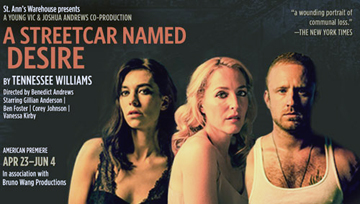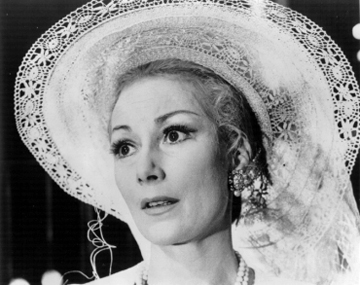Theatre: The Same River Twice
By Wendy Caster
September 1 2016
 St. Ann’s Warehouse Poster |
The Greek philosopher Heraclitus believed that you can never step into the same river twice because the water is ever-flowing—and also you have changed. Nor can great plays be held in place. The recent Young Vic production of A Streetcar Named Desire at St. Ann’s Warehouse in Brooklyn underlined this fascinating fact. (By the way, this essay assumes a familiarity with Streetcar and therefore contains spoilers.)
One of the people with whom I saw Streetcar, German born and raised, previously unfamiliar with the play, asked me, “What would you say it’s about?”
I stumbled my way through an answer: The battle between the (false) gentility of the landed gentry and the hard work of the “lower” class. The lack of options available for women, particularly women who like sex. The destruction of sensitive people by life’s realities. The danger of clashing egos. The straitjacket limitations of social rules. But I didn’t feel that I'd done Streetcar justice. That’s the richness of Streetcar: real, complex, difficult to pin down. Alive. You can’t see the same Streetcar twice. (You and I can’t even see the same Streetcar once, even if we sit next to each other at the same performance, since we all bring our individual experiences, beliefs, and assumptions to everything we see.)
I have seen Streetcar seven times, starting in the 1970s, and each production has had its own focus, balance (or lack thereof), and set of beliefs. Different directors, actors, scenery, audiences—all made a difference.
 Rosemary Harris as Blanche |
The first time I saw Streetcar, Blanche was played by the elegant Rosemary Harris, and her performance imprinted on me in a way that was perhaps unfair to Stanley. Anyone who could be mean to Harris’s Blanche was a brute, plain and simple, with no redeeming features or justification. But later productions showed me a more human Stanley—and emphasized Blanche’s condescending, even nasty, side. Christopher Innvar’s Stanley, in a production at the Barrington Stage Company in Massachusetts, was coarse and strong, but Blanche’s barbs hurt his feelings, making him more sympathetic and making the play more balanced.
A pivotal part of Streetcar is the rape scene. When I was in college, a young male professor said that Blanche had been “asking for it.” He was proud of that interpretation, which he found edgy and insightful. Would that professor get chastised, even picketed, in 2016? Possibly. But it was the 1970s, and the idea of “asking for it”—and the idea of rape as a sexual rather than violent act—was much more accepted.
Elia Kazan, the famed director of the original production and movie, shared the “asking for it” interpretation. He said, “Blanche Dubois comes into a house where someone is going to murder her. The interesting part of it is that Blanche Dubois/Williams is attracted to the person who’s going to murder her. That’s what makes the play deep…. So you can understand a woman playing affectionately with an animal that’s going to kill her. So she at once wants him to rape her, and knows he will kill her. She protests how vulgar and corrupted he is, but she also finds that vulgarity and corruption attractive.” Kazan confused Blanche’s wanting Stanley, which she probably does, with her wanting to be raped, which is a different thing entirely. Yet his interpretation was the defining one for years.
Kazan also said, in a letter refusing to allow censorship of the movie version of Streetcar, “I will not have Stanley stop short of the rape. I don't believe he would have, do you? Also, the rape is his final act in destroying her. If you want a ‘heavy’ in the piece, it's Stanley. Perhaps Blanche could never have been saved, but I certainly think it should look that way for the moment, with Mitch. The story of the latter half of this play is that Stanley doggedly hunts her down, down, down into the ground and finally makes her dirt by taking her against her will. She acts to bring it on, but he does it.”
Did Williams himself think that Blanche was “asking for it”? Did he even define the scene as rape? His stage directions are ambiguous: “She moans…. She sinks to her knees. He picks up her inert figure and carries her to the bed. The hot trumpet and drums from the Four Deuces sound loudly.” Is he truly describing rape? That is the accepted interpretation, yet in some productions, it is treated more as a seduction. It’s interesting to wonder what Williams would have written in the stage directions in the 1980s, 2000s, or today. He might have been more explicit—and that might have been less interesting!
 Vivien Leigh, Marlon Brando |
Stanley does say, “We've had this date with each other from the beginning!” But Stanley is a drunk oaf. The kindest interpretation is that he’s cheating with his sister-in-law while his wife gives birth. He’s not a reliable source of information on this topic.
I asked my 22-year-old niece what she thought about the rape scene, and she answered in the 21st century language of consent guidelines and “no means no.” It was a fascinating and intelligent answer, and it made her Streetcar a different one than mine—even though we had seen the same performance—and certainly a different one than Kazan’s.
For me, while Stanley’s behavior is unforgiveable, he’s not completely unsympathetic. This woman, a stranger to him, comes into his home, insults him, condescends to him, drinks his whiskey, monopolizes the bathroom, treats his wife like a servant, messes with his marriage, and is generally a major pain in his ass. And, yes, she teases him sexually. By raping Blanche, Stanley reclaims his turf and his masculinity in the way he knows best, violently (even though he has already ruined her life by ending her courtship with Mitch). The rape is the final attack in a war he has already won.
Also, while Stanley honestly believes he has helped Mitch by ending Mitch and Blanche’s relationship, I think he’s wrong. Blanche would have made Mitch feel tremendously alive, while Mitch would have made Blanche feel safe. Not a bad trade-off.
Another area ripe for interpretation is whether Blanche is an alcoholic. I think she is, but I don’t think that’s all that she is. One of the many reasons I disliked Cate Blanchett’s interpretation of Blanche is that it had only three levels: drunk, drunker, and incredibly drunk. When Stanley attacked her, she was so totally incapacitated by liquor that he was not just a rapist, but a really, really creepy rapist.
Even the smallest detail can affect a play significantly. Streetcar ends with the line, “This game is seven-card stud.” Blanche has been taken away, and life goes on. Any ripples she has made have already died out. Mitch is in agony, but the others just want to play cards.
 Liv Ullman, Cate Blanchett (photo: Brigitte Lacombe) |
In the Blanchett version, directed by Liv Ullman, that line was missing. Instead, we had Blanche, in her slip, standing at just the right angle for the lights to illuminate Blanchett’s alabaster skin. Ullman replaced pathos with posturing.
In the version at St. Ann’s, however, the poker player said the line with a little catch in his voice, acknowledging that something awful had just happened. It was tremendously moving. I prefer the line said more matter-of-factly, but this was a legitimate interpretation that shone a small new light on the play.
I’ve just skimmed Streetcar’s surface here. People have written thousands of words on the play, and will continue to do so. Streetcar may last hundreds of years, allowing as many discussions, reinterpretations, and reinventions as Hamlet. It’s the deepest rivers that are the most rewarding to explore.
( Wendy Caster is an award-winning writer living in New York City. Her reviews appear regularly on the blog Show Showdown. Her short plays You Look Just Like Him and The Morning After were performed as part of Estrogenius festivals. Her published works include short stories, essays, and one book. )
